A suit is a set of garments with matching pieces, typically a jacket and trousers.
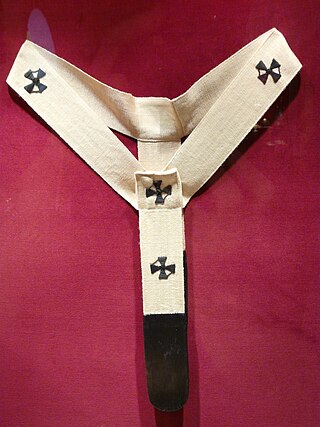
The pallium is an ecclesiastical vestment in the Catholic Church, originally peculiar to the Pope, but for many centuries bestowed by the Holy See upon metropolitans and primates as a symbol of their conferred jurisdictional authorities, and still remains a papal emblem.

A cloak is a type of loose garment worn over clothing, mostly but not always as outerwear for outdoor wear, serving the same purpose as an overcoat, protecting the wearer from the weather. It may form part of a uniform. People in many different societies may wear cloaks. Over time cloak designs have changed to match fashion and available textiles.
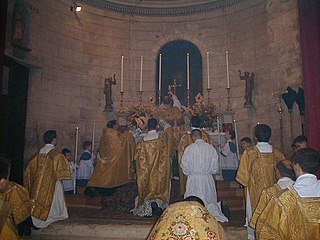
Vestments are liturgical garments and articles associated primarily with the Christian religion, especially by Eastern Churches, Catholics, Lutherans, and Anglicans. Many other groups also make use of liturgical garments; among the Reformed (Calvinist) Churches this was a point of controversy in the Protestant Reformation and sometimes since, in particular during the ritualist controversies in the Church of England in the 19th century.
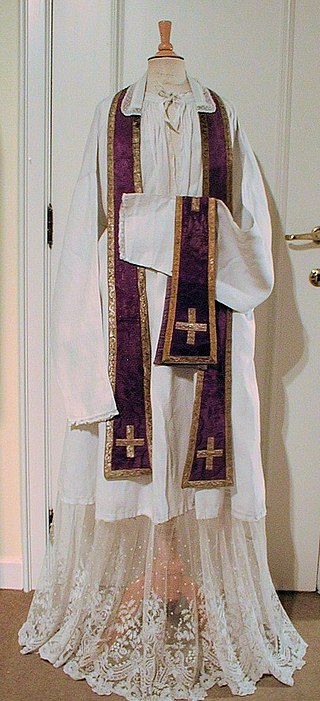
The stole is a liturgical vestment of various Christian denominations, which symbolizes priestly authority; in Protestant denominations which do not have priests but use stoles as a liturgical vestment, however, it symbolizes being a member of the ordained. It consists of a band of colored cloth, usually of silk, about seven and a half to nine feet long and three to four inches wide, whose ends may be straight or may broaden out in the shape of a spade or bell. The center of the stole is worn around the back of the neck and the two ends hang down parallel to each other in front, either attached to each other or hanging loose. The stole is almost always decorated in some way, usually with two crosses, or sometimes another significant religious design. It is often decorated with contrasting galloons and fringe is usually applied to the ends of the stole following Numbers 15:38–39. A piece of white linen or lace may be stitched onto the back of the collar as a sweat guard, which can be replaced more cheaply than the stole itself.

In the Eastern Orthodox and Eastern Catholic liturgical tradition, the omophorion is the distinguishing vestment of a bishop and the symbol of his spiritual and ecclesiastical authority. Originally woven of wool, it is a band of brocade decorated with four crosses and an eight-pointed star; it is worn about the neck and shoulders.
A mantle is a piece of clothing, a type of cloak. Several other meanings are derived from that.

Papal regalia and insignia are the official items of attire and decoration proper to the Pope in his capacity as the visible head of the Catholic Church and sovereign of the Vatican City State.
Protodeacon derives from the Greek proto- meaning 'first' and diakonos, which is a standard ancient Greek word meaning "assistant", "servant", or "waiting-man". The word in English may refer to any of various clergy, depending upon the usage of the particular church in question.
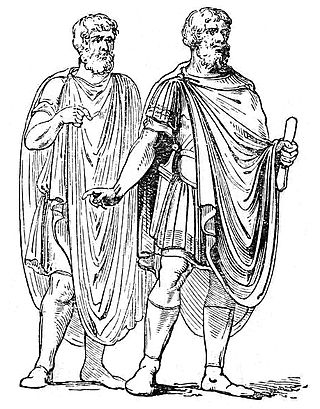
An abolla was a cloak-like garment worn by ancient Greeks and Romans. Nonius Marcellus quotes a passage of Varro to show that it was a garment worn by soldiers, and thus opposed to the toga. Roman women also wore a version of the abolla by at least the Imperial Period.

The palla was an elegant cloak or mantle that was wrapped around the body. It was worn outside the house by (affluent) Roman women. It was a luxurious version of the Roman women's pallium. The palla was a traditional ancient Roman mantle worn by women, fastened by brooches. The shape was rectangular instead of semi-circular, as with the traditional toga. The garment dates to the 3rd century BC, but the type of dress must be much older. In Latin literature, the term palla is used ambiguously. It can denote not only a cloak, but also a foot-long sleeveless dress with straps worn directly on the skin. The second is a common dress form in the entire Mediterranean world. In a Greek cultural context, this is called peplos. In a Roman cultural context, if worn by a Roman matron, it also takes the name stola.

The paenula or casula was a cloak worn by the Romans, akin to the poncho. The paenula was usually closed in the front but, occasionally, could be left with a open front; it could be also made with shorter sides to increase mobility for the arms. This was originally worn only by slaves, soldiers and people of low degree; in the 3rd century, however, it was adopted by fashionable people as a convenient riding or travelling cloak, and finally, by the sumptuary law of 382 it was prescribed as the proper everyday dress of senators, instead of the military chlamys. Thereafter, the toga was reserved for state occasions.
Birdbrain or bird brain may refer to:
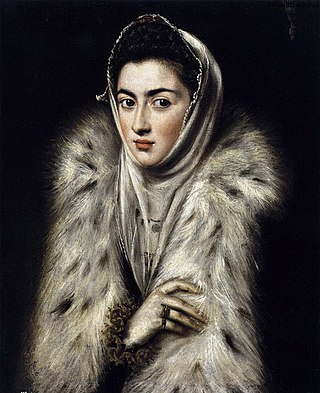
In the context of clothing, a wrap can refer to a shawl or stole or other fabric wrapped about the upper body, or a simple skirt-type garment made by wrapping a piece of material round the lower body. Many people of all genders throughout the world wear wraps in everyday life, although in the West they are largely worn by women. They are sometimes sewn at the edges to form a tube which keeps the required size. A wrap may be secured by a corner being tucked beneath the wrapped material, by making a knot, or using ties, buttons or velcro.

The pallium was a Roman cloak. It was similar in form to the palla, which had been worn by respectable Roman women since the mid-Republican era. It was a rectangular length of cloth, as was the himation in ancient Greece. It was usually made from wool or flax, but for the higher classes it could be made of silk with the use of gold threads and embroideries.
This page is based on this
Wikipedia article Text is available under the
CC BY-SA 4.0 license; additional terms may apply.
Images, videos and audio are available under their respective licenses.










